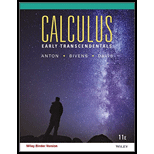
Concept explainers
In this exercise we will use the Remainder Estimation Theorem to determine the number of terms that are required in Formula (14) to approximate ln2 to five decimal-place accuracy. For this purpose let
f(x)=ln1+x1−x=ln(1+x)−ln(1−x) (−1<x<1)
(a) Show that f(n+1)(x)=n![(−1)n(1+x)n+1+1(1−x)n+1]
(b) Use the result in part (a) to show that |f(n+1)(x)|≤n!⌈1(1+x)n+1+1(1−x)n+1⌉
(c) Since we want to achieve five decimal-place accuracy, our goal is to choose n so that the absolute value of the nth remainder at x=13 does not exceed the value 0.000005=0.5×10−5; that is, |Rn(13)|≤0.000005. Use the Remainder Estimation Theorem to show that this condition will be satisfied if n is chosen so that M(n+1)!(13)n+1≤0.000005 where |f(n+1)(x)|≤M on the interval [0,13].
(d) Use the result in part (b) to show that M can be taken as M=n![1+1(23)n+1]
(e) Use the results in parts (c) and (d) to show that five decimal-place accuracy will be achieved if n satisfies 1n+1[(13)n+1+(12)n+1]≤0.000005 and then show that the smallest value of n that satisfies this condition is n=13.
Want to see the full answer?
Check out a sample textbook solution
Chapter 9 Solutions
Calculus Early Transcendentals, Binder Ready Version
Additional Math Textbook Solutions
Basic Business Statistics, Student Value Edition
Elementary Statistics (13th Edition)
A Problem Solving Approach To Mathematics For Elementary School Teachers (13th Edition)
A First Course in Probability (10th Edition)
College Algebra (7th Edition)
Elementary Statistics: Picturing the World (7th Edition)
- Number 4 plsarrow_forwardGood Day, Would appreciate any assistance with this query. Regards,arrow_forwardThis question builds on an earlier problem. The randomized numbers may have changed, but have your work for the previous problem available to help with this one. A 4-centimeter rod is attached at one end to a point A rotating counterclockwise on a wheel of radius 2 cm. The other end B is free to move back and forth along a horizontal bar that goes through the center of the wheel. At time t=0 the rod is situated as in the diagram at the left below. The wheel rotates counterclockwise at 1.5 rev/sec. At some point, the rod will be tangent to the circle as shown in the third picture. A B A B at some instant, the piston will be tangent to the circle (a) Express the x and y coordinates of point A as functions of t: x= 2 cos(3πt) and y= 2 sin(3t) (b) Write a formula for the slope of the tangent line to the circle at the point A at time t seconds: -cot(3πt) sin(3лt) (c) Express the x-coordinate of the right end of the rod at point B as a function of t: 2 cos(3πt) +411- 4 -2 sin (3лt) (d)…arrow_forward
- Algebra & Trigonometry with Analytic GeometryAlgebraISBN:9781133382119Author:SwokowskiPublisher:Cengage

 Big Ideas Math A Bridge To Success Algebra 1: Stu...AlgebraISBN:9781680331141Author:HOUGHTON MIFFLIN HARCOURTPublisher:Houghton Mifflin Harcourt
Big Ideas Math A Bridge To Success Algebra 1: Stu...AlgebraISBN:9781680331141Author:HOUGHTON MIFFLIN HARCOURTPublisher:Houghton Mifflin Harcourt 



